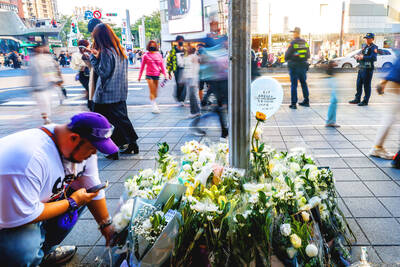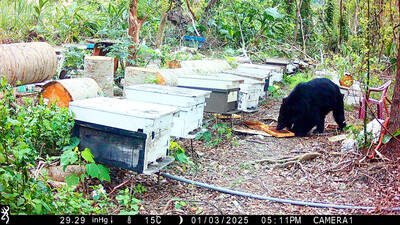Skeletal muscle mass (SMM) — the density of a person’s muscles used to power the movement of their skeleton — is a key factor in determining their life expectancy, according to a study published on Monday by the National Health Research Institutes (NHRI).
Elderly people who have lower SMM measurements might face double the risk of death compared with their peers, the study said.
The study was conducted over a nine-year period, beginning in 1999. It tracked the SMM and body-mass index (BMI) measurements of 1,512 elderly people to determine if there was any correlation between the two figures and the risk of death. Results of the survey showed that elderly people with the highest BMI rating had the least risk of death, while underweight senior citizens faced the highest risk.
The study grouped the test subjects into four categories according to their BMI measurements. Those with a BMI less than 22 were classified as underweight; 22 to 24 as average; and 24 to 27 as overweight, while those with a BMI above 27 were categorized as obese.
The mortality rate for underweight elderly people was 6.72 percent, while the risk of death for the three other BMI categories ranged from 3.76 to 3.5 percent.
The institutes urged the public to stop fixating on BMI as an indicator of good health, adding that ideal SMM should be lower than 11.4kg per cubic meter for men and 8.6kg per cubic meter for women.
Exercising regularly is the best solution to prevent the onset of muscle mass loss, which commences at an annual rate of 1 to 2 percent after the age of 40 and accelerates after 50, the NHRI said.
It also recommended that elderly people eat ample amounts of protein from healthy food sources to help replenish dwindling muscle, adding that vegetables help reduce muscle inflammation.

SHIPS, TRAINS AND AUTOMOBILES: The ministry has announced changes to varied transportation industries taking effect soon, with a number of effects for passengers Beginning next month, the post office is canceling signature upon delivery and written inquiry services for international registered small packets in accordance with the new policy of the Universal Postal Union, the Ministry of Transportation and Communications said yesterday. The new policy does not apply to packets that are to be delivered to China, the ministry said. Senders of international registered small packets would receive a NT$10 rebate on postage if the packets are sent from Jan. 1 to March 31, it added. The ministry said that three other policies are also scheduled to take effect next month. International cruise ship operators

HORROR STORIES: One victim recounted not realizing they had been stabbed and seeing people bleeding, while another recalled breaking down in tears after fleeing A man on Friday died after he tried to fight the knife-wielding suspect who went on a stabbing spree near two of Taipei’s busiest metro stations, Taipei Mayor Chiang Wan-an (蔣萬安) said. The 57-year-old man, identified by his family name, Yu (余), encountered the suspect at Exit M7 of Taipei Main Station and immediately tried to stop him, but was fatally wounded and later died, Chiang said, calling the incident “heartbreaking.” Yu’s family would receive at least NT$5 million (US$158,584) in compensation through the Taipei Rapid Transit Corp’s (TRTC) insurance coverage, he said after convening an emergency security response meeting yesterday morning. National

PLANNED: The suspect visited the crime scene before the killings, seeking information on how to access the roof, and had extensively researched a 2014 stabbing incident The suspect in a stabbing attack that killed three people and injured 11 in Taipei on Friday had planned the assault and set fires at other locations earlier in the day, law enforcement officials said yesterday. National Police Agency (NPA) Director-General Chang Jung-hsin (張榮興) said the suspect, a 27-year-old man named Chang Wen (張文), began the attacks at 3:40pm, first setting off smoke bombs on a road, damaging cars and motorbikes. Earlier, Chang Wen set fire to a rental room where he was staying on Gongyuan Road in Zhongzheng District (中正), Chang Jung-hsin said. The suspect later threw smoke grenades near two exits

The Forestry and Nature Conservation Agency yesterday launched a gift box to market honey “certified by a Formosan black bear” in appreciation of a beekeeper’s amicable interaction with a honey-thieving bear. Beekeeper Chih Ming-chen (池明鎮) in January inspected his bee farm in Hualien County’s Jhuosi Township (卓溪) and found that more than 20 beehives had been destroyed and many hives were eaten, with bear droppings and paw prints near the destroyed hives, the agency said. Chih returned to the farm to move the remaining beehives away that evening when he encountered a Formosan black bear only 20m away, the agency said. The bear